Spaceships and Rockets
International Partner Rockets and Spacecraft
The International Space Station brings together international flight crews; multiple launch vehicles; globally distributed launch, operations, training, engineering, and development facilities; communications networks; and the international scientific research community.
Launched in 1998 and involving the U.S., Russia, Canada, Japan, and the participating countries of the European Space Agency—the International Space Station is the largest space station ever constructed. The orbiting laboratory continues to be assembled in orbit and has been visited by astronauts from 18 countries—and counting. The station requires the support of facilities on Earth managed by all of the international partner agencies, countries, and commercial entities involved in the program.
Progress Cargo Ship
The Progress resupply vehicle is an automated, unpiloted version of the Soyuz spacecraft that is used to bring supplies and fuel to the International Space Station. The Progress also has the ability to raise the station’s altitude and control the orientation of the station using the vehicle’s thrusters.
Both the Progress M and M1 versions have a pressurized Cargo Module to carry supplies, a Refueling Module that holds fuel tanks containing propellant and pressurized gases, and an Instrumentation/Propulsion Module where the Progress systems equipment and thrusters are located.
The Progress spacecraft is launched to the space station from the Baikonur Cosmodrome in Kazakhstan aboard a Soyuz rocket. It normally docks to the end of the Station’s Zvezda Service Module, but it can also dock to the bottom of the Pirs Docking Compartment.
Soyuz Crew Ship
The Soyuz spacecraft is launched to the space station from the Baikonur Cosmodrome in Kazakhstan aboard a Soyuz rocket. It consists of an Orbital Module, a Descent Module and an Instrumentation/Propulsion Module.
Orbital Module
This portion of the Soyuz spacecraft is used by the crew while on orbit during free-flight. It has a volume of 6.5 cubic meters (230 cubic feet), with a docking mechanism, hatch and rendezvous antennas located at the front end. The docking mechanism is used to dock with the space station and the hatch allows entry into the station. The rendezvous antennas are used by the automated docking system – a radar-based system – to maneuver towards the station for docking. There is also a window in the module.
The opposite end of the Orbital Module connects to the Descent Module via a pressurized hatch. Before returning to Earth, the Orbital Module separates from the Descent Module – after the deorbit maneuver – and burns up upon re-entry into the atmosphere.
Descent Module
The Descent Module is where the cosmonauts and astronauts sit for launch, re-entry and landing. All the necessary controls and displays of the Soyuz are located here. The module also contains life support supplies and batteries used during descent, as well as the primary and backup parachutes and landing rockets. It also contains custom-fitted seat liners for each crew member’s couch/seat, which are individually molded to fit each person’s body — this ensures a tight, comfortable fit when the module lands on Earth. When crewmembers are brought to the station aboard the space shuttle, their seat liners are brought with them and transferred to the existing Soyuz spacecraft as part of crew handover activities.
The module has a periscope, which allows the crew to view the docking target on the station or Earth below. The eight hydrogen peroxide thrusters located on the module are used to control the spacecraft’s orientation, or attitude, during the descent until parachute deployment. It also has a guidance, navigation and control system to maneuver the vehicle during the descent phase of the mission.
Instrumentation/Propulsion Module
This module contains three compartments: Intermediate, Instrumentation and Propulsion.
The intermediate compartment is where the module connects to the Descent Module. It also contains oxygen storage tanks and the attitude control thrusters, as well as electronics, communications and control equipment. The primary guidance, navigation, control and computer systems of the Soyuz are in the instrumentation compartment, which is a sealed container filled with circulating nitrogen gas to cool the avionics equipment. The propulsion compartment contains the primary thermal control system and the Soyuz radiator, which has a cooling area of 8 square meters (86 square feet). The propulsion system, batteries, solar arrays, radiator and structural connection to the Soyuz launch rocket are located in this compartment.
The propulsion compartment contains the system that is used to perform any maneuvers while in orbit, including rendezvous and docking with the space station and the deorbit burns necessary to return to Earth. The propellants are nitrogen tetroxide and unsymmetric-dimethylhydrazine. The main propulsion system and the smaller reaction control system, used for attitude changes while in space, share the same propellant tanks.
The two Soyuz solar arrays are attached to either side of the rear section of the Instrumentation/Propulsion Module and are linked to rechargeable batteries. Like the Orbital Module, the intermediate section of the Instrumentation/Propulsion Module separates from the Descent Module after the final deorbit maneuver and burns up in atmosphere upon re-entry.
Soyuz Rocket
Throughout history, more than 1,500 launches have been made with Soyuz launchers to orbit satellites for telecommunications, Earth observation, weather, and scientific missions, as well as for human flights.
The basic Soyuz vehicle is considered a three-stage launcher in Russian terms and is composed of:
A lower portion consisting of four boosters (first stage) and a central core (second stage).
An upper portion, consisting of the third stage, payload adapter and payload fairing.
Liquid oxygen and kerosene are used as propellants in all three Soyuz stages.
































